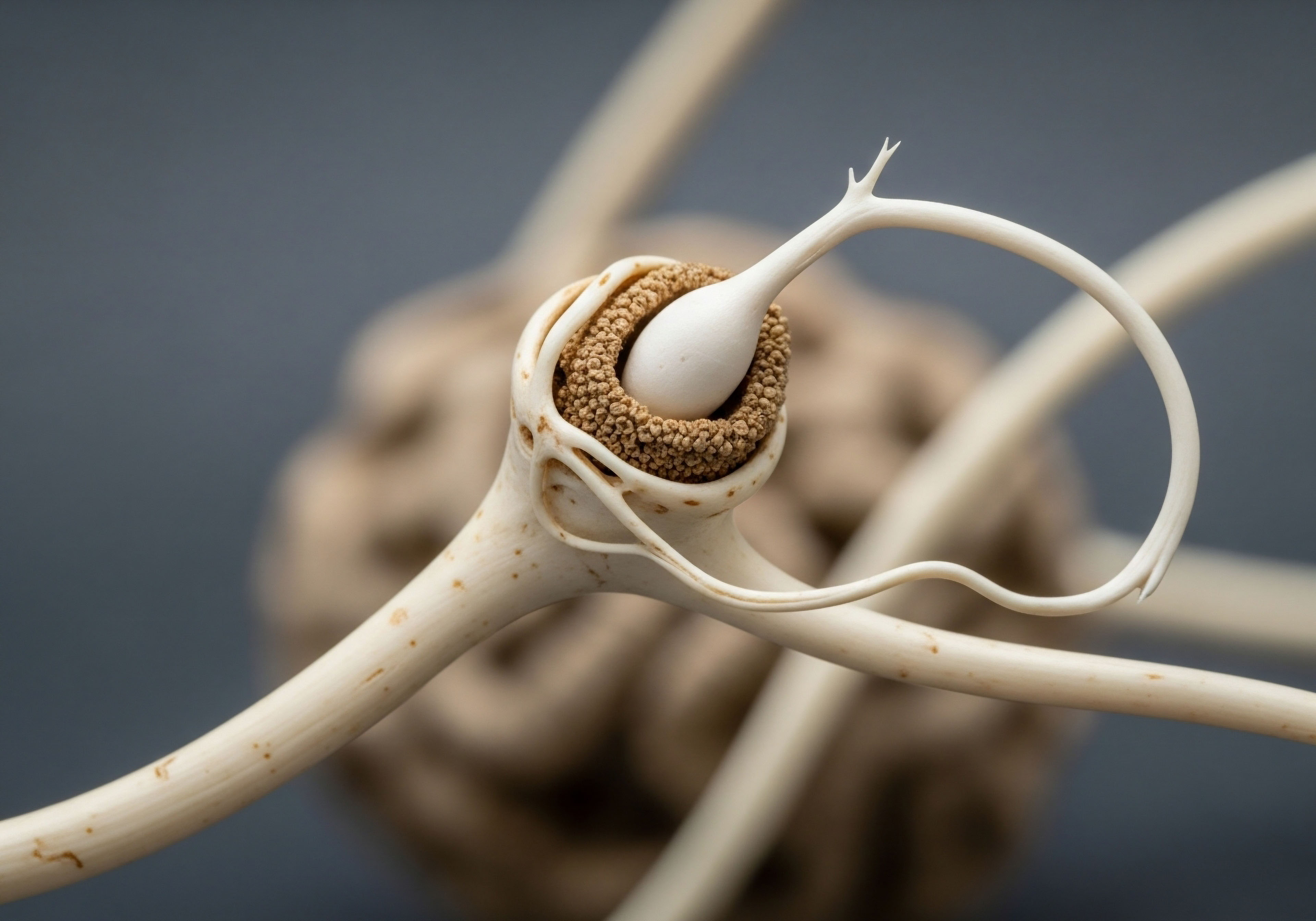

Fundamentals
That feeling of puffiness, the subtle tightness in your fingers or ankles, is a deeply personal and often frustrating experience. It’s a physical sensation that communicates a story about your internal environment. Many people feel this and are told it is just a part of life, a monthly inconvenience for women or an unexplained side effect of aging for men.
Your experience is valid, and it is rooted in precise biological mechanics. Understanding this is the first step toward reclaiming a sense of control over your own body’s systems. The sensation of fluid retention Meaning ∞ Fluid retention refers to the abnormal accumulation of excess fluid within the body’s tissues or cavities, commonly presenting as swelling or edema. is a direct message from a sophisticated internal system responsible for managing your body’s salt and water balance, and your hormones are constantly speaking to it.
At the center of this process is a cascade of proteins and hormones known as the Renin-Angiotensin-Aldosterone System, or RAAS. Think of the RAAS as your body’s master regulator for blood pressure Meaning ∞ Blood pressure quantifies the force blood exerts against arterial walls. and fluid volume. It is a powerful and essential system designed to keep you alive, ensuring your organs get the blood flow they need.
It operates through a series of steps, each one triggering the next in a precise sequence. It begins in the kidneys, which act like sensors, constantly monitoring your blood pressure. When pressure drops, the kidneys release an enzyme called renin. Renin begins the cascade by converting a protein made by the liver, called angiotensinogen, into a largely inactive form known as Angiotensin I.
Estrogen initiates a complex dialogue with the body’s fluid regulation system, influencing both the start and end points of the hormonal cascade.
From there, Angiotensin I travels to the lungs, where the Angiotensin-Converting Enzyme, or ACE, transforms it into the highly active Angiotensin II. This molecule is a potent constrictor of blood vessels, which directly increases blood pressure. Angiotensin II Meaning ∞ Angiotensin II is a highly potent peptide hormone serving as the primary active component of the renin-angiotensin-aldosterone system, critically regulating systemic blood pressure and fluid-electrolyte balance within the human body. performs another critical function ∞ it signals the adrenal glands, which sit atop your kidneys, to release aldosterone.
Aldosterone is the final actor in this part of the play. It instructs the kidneys to hold onto sodium. Where sodium goes, water follows. This retention of sodium and water increases the total volume of fluid in your bloodstream, which further raises your blood pressure, completing the feedback loop.

Estrogens Influence on the System
Estrogen, in both men and women, directly interfaces with this intricate RAAS. It does so in a complex and bidirectional manner. First, estrogen signaling encourages the liver to produce more angiotensinogen, the initial substrate for the entire cascade. This action effectively increases the potential of the system, loading it with more raw material.
This is a primary reason why shifts in estrogen levels Meaning ∞ Estrogen levels denote the measured concentrations of steroid hormones, predominantly estradiol (E2), estrone (E1), and estriol (E3), circulating within an individual’s bloodstream. can lead to a noticeable change in how much water your body retains. The system becomes more sensitive because more of the initial ingredient is available.
This hormonal influence is fundamental to the experiences of both sexes. In women, the cyclical rise and fall of estrogen during the menstrual cycle constantly adjusts the sensitivity of the RAAS. During perimenopause, as estrogen levels fluctuate unpredictably, the signals to the RAAS can become chaotic, leading to erratic periods of bloating and fluid retention.
In men, the balance between testosterone and its conversion to estrogen is key. While testosterone itself has a different set of effects, the estradiol Meaning ∞ Estradiol, designated E2, stands as the primary and most potent estrogenic steroid hormone. produced from it via the aromatase enzyme directly interacts with the RAAS.
If a man’s testosterone levels are high and the rate of aromatization into estrogen is also high, he may experience fluid retention as a direct result of this elevated estrogenic signaling. This is a common concern for individuals undergoing Testosterone Replacement Therapy Meaning ∞ Testosterone Replacement Therapy (TRT) is a medical treatment for individuals with clinical hypogonadism. (TRT) and highlights that the RAAS is a universal mechanism influenced by the specific hormonal context of the individual.


Intermediate
To truly grasp how your body modulates fluid, we must examine the specific and sometimes counterintuitive actions of estrogen within the Renin-Angiotensin-Aldosterone System. The body’s biochemistry is a world of checks and balances. While estrogen upregulates the production of angiotensinogen, the system’s starting block, it simultaneously applies a brake further down the line.
Clinical evidence shows that estrogen can inhibit the activity of the Angiotensin-Converting Enzyme (ACE). This is the very enzyme responsible for creating the potent vasoconstrictor, Angiotensin II. This dual action is a perfect example of the body’s sophisticated regulatory logic.
This creates a unique biochemical state. The system is primed with more angiotensinogen, but the conversion to its most powerful form is partially dampened. The result is that while the potential for fluid retention is increased, the body has a built-in mechanism to prevent that potential from becoming runaway hypertension.
The clinical implication is that the balance and sensitivity of the system are altered. This explains why the effects of estrogen on fluid retention can feel so variable. It depends on the interplay between the level of angiotensinogen Meaning ∞ Angiotensinogen is a glycoprotein primarily produced by the liver, serving as the sole precursor for angiotensins, potent vasoactive peptides central to blood pressure regulation. production and the degree of ACE inhibition, which can differ between individuals and change with fluctuating hormone levels.
Clinical protocols for hormonal optimization directly address estrogen’s impact on fluid balance by managing its production and effects on the RAAS.

How Does This Manifest in Clinical Practice?
In a clinical setting, understanding this bidirectional mechanism is foundational to creating effective hormonal optimization Meaning ∞ Hormonal Optimization is a clinical strategy for achieving physiological balance and optimal function within an individual’s endocrine system, extending beyond mere reference range normalcy. protocols. The goal is to restore balance to the system, validating the patient’s symptoms while addressing the underlying biochemical drivers. This is particularly relevant in the management of hormone replacement therapies for both men and women.

Hormone Protocols for Women
For women in perimenopause or post-menopause, fluctuating or declining estrogen levels disrupt the established rhythm of the RAAS. Protocols involving hormonal support, which may include bioidentical estradiol and progesterone, aim to restore a more stable physiological state. Progesterone itself has a mild diuretic effect, acting as a natural antagonist to aldosterone Meaning ∞ Aldosterone is a potent steroid hormone produced by the adrenal cortex’s zona glomerulosa. at the kidney’s mineralocorticoid receptors.
This provides a gentle, opposing force to the fluid-retaining effects of estrogen. The therapeutic goal is to balance these hormonal inputs to achieve equilibrium, reducing the distressing symptoms of bloating and puffiness that can accompany the menopausal transition. Low-dose testosterone therapy in women, when clinically indicated, is carefully monitored for its potential conversion to estradiol, ensuring the benefits of the therapy are realized without creating an estrogen-dominant state that would over-stimulate the RAAS.

Testosterone Replacement Therapy in Men
For a man on a TRT protocol, managing estrogen is a central component of successful therapy. A standard protocol may involve weekly intramuscular injections of Testosterone Cypionate. A portion of this testosterone will naturally be converted into estradiol by the aromatase enzyme.
While some estrogen is essential for male health, including bone density and libido, excessive levels can lead to unwanted side effects, with fluid retention being one of the most common. This occurs because the elevated estradiol levels stimulate angiotensinogen production, sensitizing the RAAS.
To manage this, clinical protocols often include an aromatase inhibitor Meaning ∞ An aromatase inhibitor is a pharmaceutical agent specifically designed to block the activity of the aromatase enzyme, which is crucial for estrogen production in the body. (AI) like Anastrozole. This medication works by blocking the aromatase enzyme, thereby reducing the conversion of testosterone to estradiol. By keeping estradiol levels within an optimal range, Anastrozole directly mitigates estrogen’s stimulatory effect on the RAAS, helping to prevent or resolve fluid retention.
The inclusion of Gonadorelin in such protocols helps maintain the body’s own testicular function and hormonal production, creating a more integrated and balanced endocrine environment. The careful calibration of Testosterone, Anastrozole, and Gonadorelin allows for the optimization of male hormonal health while actively preventing side effects like water retention.
This table illustrates the effects of different estrogen levels on the RAAS and the resulting physical symptoms in both men and women.
| Hormonal State | Effect on Angiotensinogen | Effect on ACE Activity | Net RAAS Sensitivity | Common Physical Symptoms |
|---|---|---|---|---|
| Balanced Estrogen | Normal Production | Slightly Inhibited | Regulated | Stable fluid balance, minimal bloating. |
| High Estrogen (e.g. Unmanaged TRT, PMS) | Increased Production | Inhibited | Increased | Noticeable fluid retention, puffiness, bloating, potential for elevated blood pressure. |
| Low Estrogen (e.g. Post-menopause) | Decreased Production | Less Inhibited | Dysregulated | Erratic fluid shifts, though often less overall retention than high-estrogen states. |

The Vasodilatory Pathway an Important Counterbalance
The story has another layer. The inhibition of ACE by estrogen has a secondary, beneficial effect. It allows for the accumulation of another peptide, Angiotensin-(1-7). This peptide is formed from Angiotensin I through a different enzymatic pathway, and it possesses actions that directly oppose Angiotensin II.
Angiotensin-(1-7) is a vasodilator; it relaxes blood vessels and promotes the excretion of sodium and water from the kidneys. By inhibiting ACE, estrogen indirectly shunts the RAAS cascade toward this protective, vasodilatory pathway. This is a critical aspect of estrogen’s cardiovascular protective effects and adds another degree of sophistication to its role in fluid dynamics. It showcases a system that is not simply about fluid retention, but about maintaining a dynamic, healthy equilibrium in the body.


Academic
A deeper examination of estrogen’s influence on fluid homeostasis requires a shift in perspective from systemic effects to the molecular and tissue-specific actions mediated by estrogen receptors within the cardiovascular and renal systems. The bidirectional impact of estrogen on the Renin-Angiotensin-Aldosterone System Meaning ∞ The Renin-Angiotensin-Aldosterone System, or RAAS, is a crucial hormonal cascade regulating blood pressure, fluid volume, and electrolyte balance. is a consequence of differential signaling through its primary receptor subtypes, Estrogen Receptor Alpha (ERα) and Estrogen Receptor Beta (ERβ).
These receptors are expressed in varying densities in key tissues that govern the RAAS, including the liver, vascular endothelium, adrenal cortex, and specific segments of the renal tubules. The net effect of estrogen on an individual’s fluid balance Meaning ∞ Fluid balance refers to the precise equilibrium between the volume of water and solutes entering and leaving the body, essential for sustaining cellular integrity and systemic physiological functions. is a composite of these localized, receptor-mediated actions.
The genomic effects of estrogen are responsible for the well-documented increase in hepatic angiotensinogen synthesis. Activation of ERα in hepatocytes upregulates the transcription of the angiotensinogen gene, leading to higher circulating levels of the RAAS precursor. This is a relatively slow, transcriptionally-mediated process.
Concurrently, estrogen exerts non-genomic, rapid effects within the vasculature. Through ERα activation in endothelial cells, estrogen stimulates the production of Nitric Oxide (NO), a potent vasodilator that directly counteracts the vasoconstrictive effects of Angiotensin II. This immediate vasodilatory action provides a rapid counterbalance to the slower, pro-hypertensive potential of increased angiotensinogen.
The specific estrogen receptor subtypes activated within the kidney and vasculature determine the ultimate physiological response to hormonal signaling.

What Is the Role of Intrarenal RAAS Regulation?
The circulating RAAS is only part of the story. Many tissues possess their own local RAAS, which allows for fine-tuned, paracrine regulation of tissue function. The intrarenal RAAS is particularly important for sodium and water handling. Estrogen, through its receptors, directly modulates the components of this local system.
For instance, estrogen has been shown to downregulate the expression of the Angiotensin II Type 1 Receptor (AT1R) in renal tissues. The AT1R is the primary receptor through which Angiotensin II exerts its vasoconstrictive and sodium-retaining effects. By reducing the density of these receptors, estrogen effectively desensitizes the kidney to the actions of Angiotensin II, even if circulating levels of the peptide are elevated.
Furthermore, the enzyme ACE2, a homolog of ACE, plays a critical role. ACE2 metabolizes Angiotensin II into the vasodilator peptide Angiotensin-(1-7). Research suggests that estrogen can upregulate the expression and activity of ACE2. This action serves two purposes ∞ it degrades the pro-hypertensive Angiotensin II while simultaneously increasing the production of the anti-hypertensive Angiotensin-(1-7).
This shunting of the cascade toward the vasodilatory arm of the RAAS within the kidney itself is a powerful mechanism for maintaining fluid and electrolyte homeostasis and represents a key target of estrogen’s renal effects.
The following list outlines the key molecular actions of estrogen within the RAAS cascade:
- Hepatic Angiotensinogen Synthesis ∞ Estrogen receptor alpha (ERα) activation in the liver increases the transcription of the angiotensinogen gene, elevating the substrate for the entire RAAS.
- ACE Inhibition ∞ Estrogen can directly inhibit the activity of Angiotensin-Converting Enzyme (ACE) in the lungs and other tissues, reducing the rate of conversion of Angiotensin I to the potent Angiotensin II.
- AT1R Downregulation ∞ Estrogen signaling, particularly through ERα, can decrease the expression of Angiotensin II Type 1 Receptors (AT1R) in target tissues like the kidneys and blood vessels, blunting the effect of Angiotensin II.
- ACE2 Upregulation ∞ Estrogen can increase the activity of ACE2, an enzyme that degrades Angiotensin II and produces the beneficial vasodilator Angiotensin-(1-7).

Implications for Therapeutic Interventions
This systems-biology perspective has profound implications for clinical practice, particularly in the context of hormone replacement and cardiovascular health. The choice of estrogen, its route of administration (oral versus transdermal), and the hormonal milieu in which it is introduced all matter.
Oral estrogens undergo first-pass metabolism in the liver, which can lead to a more pronounced increase in angiotensinogen production compared to transdermal preparations. This is a key reason why transdermal hormone therapy may be associated with a more neutral effect on blood pressure and fluid balance.
In the context of male TRT, the goal of Anastrozole Meaning ∞ Anastrozole is a potent, selective non-steroidal aromatase inhibitor. therapy is to limit the systemic estradiol levels to prevent the overstimulation of hepatic angiotensinogen production. The therapeutic window is critical; excessive suppression of estradiol can be detrimental, as a baseline level of estrogenic activity is required for its beneficial effects on vascular health and the modulation of the RAAS, including AT1R downregulation and ACE2 activity.
This table details the divergent roles of the two main estrogen receptor Meaning ∞ Estrogen receptors are intracellular proteins activated by the hormone estrogen, serving as crucial mediators of its biological actions. subtypes on components of the RAAS.
| RAAS Component | Effect of ERα Activation | Effect of ERβ Activation | Net Physiological Consequence |
|---|---|---|---|
| Angiotensinogen Gene | Upregulation (in liver) | Minimal Effect | Increased substrate for RAAS cascade. |
| AT1 Receptor Expression | Downregulation | Downregulation | Reduced sensitivity to Angiotensin II. |
| Endothelial Nitric Oxide | Increased Production | Increased Production | Vasodilation, counteracting Ang II effects. |
| ACE2 Expression | Upregulation | Upregulation | Increased degradation of Ang II and production of Ang-(1-7). |
Ultimately, the relationship between estrogen and fluid retention is a demonstration of complex biological modulation. Estrogen acts as a fulcrum, balancing the pro-hypertensive potential of increased RAAS substrate with multi-level inhibitory and vasodilatory actions within the vasculature and kidneys.
Pathological fluid retention arises when this delicate balance is disrupted, either by supraphysiological hormone levels, rapid fluctuations, or an underlying dysregulation in one of the system’s core components. Therapeutic strategies must therefore be aimed at restoring this physiological equilibrium, using an approach that appreciates the interconnectedness of the entire system.

References
- White, M. C. et al. “Estrogen, natriuretic peptides and the renin ∞ angiotensin system.” Cardiovascular Research, vol. 41, no. 3, 1999, pp. 536-545.
- Gallagher, P. E. et al. “Bi-directional actions of estrogen on the renin-angiotensin system.” Brazilian Journal of Medical and Biological Research, vol. 32, no. 7, 1999, pp. 827-836.
- Monteiro, R. et al. “Interactions between oestrogen and the renin angiotensin system – potential mechanisms for gender differences in Alzheimer’s disease.” Journal of Neuroendocrinology, vol. 27, no. 7, 2015, pp. 549-561.
- Cleveland Clinic. “Renin-Angiotensin-Aldosterone System (RAAS).” Cleveland Clinic, 2021.
- Gallagher, P. E. et al. “Bi-directional actions of estrogen on the renin-angiotensin system.” Endocrinology, vol. 140, no. 4, 1999, pp. 1578-1583.

Reflection
The information presented here provides a map of the biological territory, connecting a feeling to a function, a symptom to a system. Your body is in a constant state of communication with itself, using these hormonal pathways to maintain a dynamic stability. The experience of fluid retention is one of these messages.
This knowledge is the starting point. It offers a framework for observing your own patterns and understanding the story your physiology is telling. The path toward true hormonal and metabolic wellness is a personal one, built on this foundation of understanding and guided by precise, individualized data. Consider what your body has been communicating to you and how this new context reframes that conversation.












